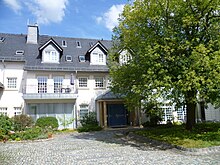Georgenthal Estate
The Hofgut Georgenthal is a farm with hotel operations in Untertaunus in the town of Hohenstein east of the district Steckenroth or north of Taunusstein - Wingsbach in Untertaunus in Hesse .
description
The estate includes around 65 hectares of arable, pasture and forest areas, which are also managed accordingly.
The associated hotel complex with 69 beds in 40 rooms has been awarded 4-star superior . The hotel has a spa area, conference rooms and several restaurant facilities. Rooms are also available for civil weddings .
The Hofgut houses the Limes information center for the Rheingau-Taunus district ( Limes im Hofgut - Regional Museum ). Original finds are also exhibited here. In addition, an educational trail on Roman settlement has been developed, which also leads to three tower points ( watchtower 3/8, 3/9 and 3/10 ).
The managing director Brita Hankammer announced in October 2011 that she was planning to build an 18-hole golf course around the estate. In July 2013, construction began on the golf course, which opened in September 2015.
history
The Georgenthal estate, called Georgenthaler Hof at the time , was founded in 1692 by Count Georg August Samuel von Nassau-Idstein as a so-called Zehnthof . It was one of six court foundations ( Gassenbacher Hof , Idsteiner Viehhof, Ranstatter Hof, Georgenthaler Hof, Henriettenhof and Nainhauser Hof) under his rule. The naming is to be seen as a special distinction, since the name refers to the first name of the prince. In the same way, the name of Henriettenhof refers to the first name of his wife Henriette Dorothea von Oettingen.
In the course of this re-establishment, the neighboring communities had to give up land. Were affected Hambach , Steckenroth , Strinz-Margarethä and Wingsbach . Steckenroth lost about a third of the district, Strinz-Margarethä lost the Steinwald and Wingsbach lost the Wiesengrund . While Strinz-Margarethä and Wingsbach found a balance, Steckenroth was not compensated. Accordingly, it was not until 1735 that the voting document, i.e. the definition of the border, between the Hofgut and Steckenroth was sealed.
In 1930 the estate was acquired by Georg Sauerbier.
In 1989 the courtyard burned down about halfway. The cause of the fire has not yet been clarified.
In 1995, Heinz Hankammer acquired the Hofgut, which was expanded into the current 4-star superior hotel by 2000 .
Anecdotes about the Hofgut
- Rumor has it that Georg Sauerbier received the money to purchase the estate from a lawsuit against the Reichsbahn . Allegedly, a suitcase fell from the luggage rack on his head while driving.
- When American troops liberated the area at the end of World War II , the then manager of the estate saved himself from the act of revenge by Russian and Polish prisoners of war by jumping out the window. But he was shot on his escape.
- In 1737 gypsies broke into the estate. The then courtier, Poths, probably sent a maid and a servant to Steckenroth. These triggered a major alarm here. As a result of this alarm, the bells of the local church rang so loudly that one of them burst and was replaced a year later.
- The grave of Leo and Dorothea Roveray can be found at the edge of the Hundsbuckel field . The two children died of diphtheria on the estate.
literature
- A short history of the Georgenthal estate from the Georgenthal estate
Web links
Individual evidence
- ↑ Wiesbadener Tagblatt: Quality and performance confirmed ( page no longer available , search in web archives ) Info: The link was automatically marked as defective. Please check the link according to the instructions and then remove this notice. (as of June 24, 2010)
- ↑ http://www.hofgut-georgenthal.de/de/hofgut/presse/
Coordinates: 50 ° 11 ′ 1.7 ″ N , 8 ° 8 ′ 58.3 ″ E



